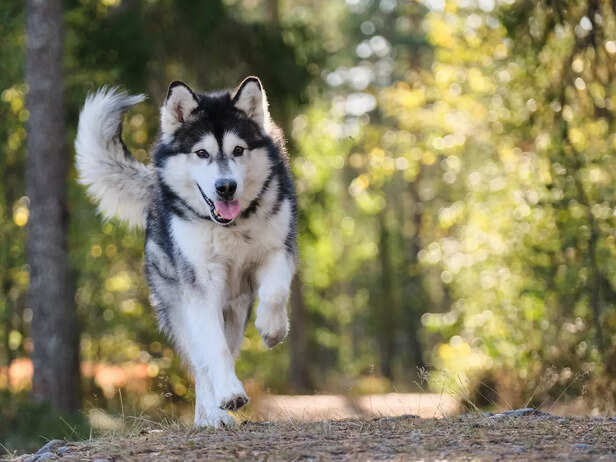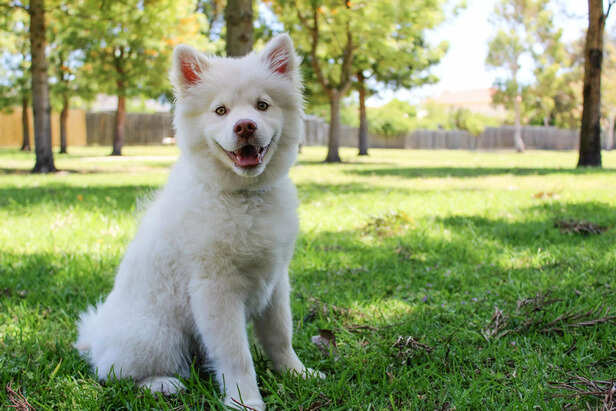Is Your Dog Actually Happy? 5 Ways to Tell
Dec 05, 2024, 20:10 IST
(Image Source : Pixabay)
Ever questioned whether your dog is genuinely happy? This article reveals five unexpected methods to find out, ranging from interpreting tail wags to watching their sleeping patterns. Understand how a calm body language, healthy independence, and enthusiasm for life indicate satisfaction. Explore what your dog’s actions indicate about their feelings and how you can enhance their joy through quality time, mental engagement, and love. Filled with useful tips and the dispelling of common misconceptions, this guide guarantees your furry companion enjoys their finest, tail-wagging existence.
As pet owners, we universally wish to think that our beloved animals are experiencing their most joyful existence. But what’s the best way to determine if your dog is as happy as they appear? Dogs may not communicate with words, yet they convey a great deal through their actions, physical demeanor, and everyday routines. Warning: Certain indicators of happiness may not align with your expectations!

We all know the classic sign of a wagging tail as a symbol of joy. But did you know that not all tail wags mean the same thing? A happy dog’s tail has its own unique language.
Here’s how to decode it:
Relaxed Wagging: A loosely wagging tail held at a neutral height (not too high or too low) is often a sign of a content and happy dog.
Helicopter Wagging: When your dog’s tail is wagging in a circular motion, they’re likely overjoyed—this is common when greeting someone they adore.
Still and High Tail: While some might think this means confidence, it could also indicate tension or alertness, not happiness.
Surprised? The key is to observe your dog’s overall body language along with their tail movement to determine their emotional state.

A happy dog is an eager eater, but their "appetite" extends beyond the food bowl. Dogs who are emotionally content also crave playtime, exploration, and social interaction.
Signs of a healthy appetite for life include:
Excitement During Mealtimes: A happy dog will eagerly anticipate food and may even do a little “dance” of joy before meals.
Playful Energy: Whether it’s chasing a ball or wrestling with their favorite toy, happy dogs engage enthusiastically in play.
Curiosity About Their Environment: A happy dog is eager to explore their surroundings, sniffing and investigating with interest.
On the flip side, if your dog shows a sudden lack of interest in food, play, or exploration, it could indicate stress or health issues.

Dogs are masters of body language, and a happy dog often displays specific cues that signal they’re feeling good. Pay attention to these telltale signs:
Soft Eyes: A relaxed, half-lidded gaze often means your dog feels safe and content.
Relaxed Ears: Whether floppy or erect, your dog’s ears should appear relaxed and not overly rigid or pinned back.
Wiggly Body: A happy dog’s body moves fluidly, often accompanied by a playful bounce or a full-body wag.
Surprising Fact: Yawning doesn’t always mean your dog is tired—it can also be a sign of happiness and relaxation, especially if it’s accompanied by a stretch!
Dogs are famously loyal, but a truly happy dog strikes a balance between staying close to you and enjoying their independence.
Here’s what this looks like:
They’re Your Shadow: If your dog often follows you around the house, it’s a sign they feel safe and bonded to you.
They Relax When You’re Gone: A happy dog doesn’t exhibit signs of severe separation anxiety. They’re comfortable being alone for short periods.
They Come to You for Comfort: When a dog feels safe and happy, they’ll approach you when they need reassurance or affection.
If your dog seems overly clingy or, conversely, avoids you, it may be worth investigating potential stressors in their environment.

Surprise! A dog’s sleep habits can tell you a lot about their happiness. Dogs who feel safe and content tend to have consistent, restful sleep patterns.
Here’s what to watch for:
Frequent Snoozes: Dogs spend about 12-14 hours a day sleeping, depending on their age and breed. Happy dogs nap peacefully throughout the day.
Sleep Positions: Dogs who sleep on their backs with their paws in the air are often feeling completely relaxed and secure.
Dreaming: If your dog twitches, barks softly, or paddles their legs while asleep, it’s a sign they’re in a deep, restorative sleep—and probably dreaming about chasing squirrels!
Interrupted sleep or excessive restlessness could be a sign of discomfort, anxiety, or health issues.
Now that you know how to spot the signs of a happy dog, here are a few easy ways to make your pup even more joyful:
Spend Quality Time Together: Whether it’s a long walk, a game of fetch, or simply lounging on the couch, your dog values time with you more than anything.
Provide Mental Stimulation: Puzzle toys, training sessions, and new experiences keep your dog’s mind sharp and engaged.
Create a Safe Space: Ensure your dog has a quiet, cozy spot where they can retreat when they need rest or alone time.
Stay Consistent: Dogs thrive on routine, so regular meal times, walks, and bedtime help them feel secure.
Show Affection: A belly rub, a kind word, or even just sitting together in silence lets your dog know they’re loved.
Common Misconceptions About Dog Happiness
Myth: A wagging tail always means happiness.
Truth: Tail wags can also indicate nervousness, fear, or excitement.
Myth: A hyper dog is a happy dog.
Truth: Excessive energy can sometimes be a sign of anxiety or boredom.
Myth: Dogs who sleep a lot are lazy.
Truth: Sleeping is natural and healthy for dogs, especially when they feel safe and content.
If your dog suddenly shows signs of unhappiness—such as avoiding play, refusing food, excessive barking, or changes in sleep patterns—it’s important to investigate.
Check for Health Issues: A trip to the vet can rule out any underlying medical problems.
Evaluate Their Environment: Stressors like loud noises, lack of exercise, or changes in routine can affect your dog’s mood.
Consult a Trainer or Behaviorist: If your dog’s behavior changes significantly, professional help can identify and address the issue.
1. Their Tail Tells a Tale—but Not in the Way You Think

Waving tail (Image Source : Pixabay)
We all know the classic sign of a wagging tail as a symbol of joy. But did you know that not all tail wags mean the same thing? A happy dog’s tail has its own unique language.
Here’s how to decode it:
Relaxed Wagging: A loosely wagging tail held at a neutral height (not too high or too low) is often a sign of a content and happy dog.
Helicopter Wagging: When your dog’s tail is wagging in a circular motion, they’re likely overjoyed—this is common when greeting someone they adore.
Still and High Tail: While some might think this means confidence, it could also indicate tension or alertness, not happiness.
Surprised? The key is to observe your dog’s overall body language along with their tail movement to determine their emotional state.
2. They Have a Healthy Appetite—but Not Just for Food

(Image Source : Pexels)
A happy dog is an eager eater, but their "appetite" extends beyond the food bowl. Dogs who are emotionally content also crave playtime, exploration, and social interaction.
Signs of a healthy appetite for life include:
Excitement During Mealtimes: A happy dog will eagerly anticipate food and may even do a little “dance” of joy before meals.
Playful Energy: Whether it’s chasing a ball or wrestling with their favorite toy, happy dogs engage enthusiastically in play.
Curiosity About Their Environment: A happy dog is eager to explore their surroundings, sniffing and investigating with interest.
On the flip side, if your dog shows a sudden lack of interest in food, play, or exploration, it could indicate stress or health issues.
3. Their Body Language Speaks Volumes

(Image Source : Pexels)
Dogs are masters of body language, and a happy dog often displays specific cues that signal they’re feeling good. Pay attention to these telltale signs:
Soft Eyes: A relaxed, half-lidded gaze often means your dog feels safe and content.
Relaxed Ears: Whether floppy or erect, your dog’s ears should appear relaxed and not overly rigid or pinned back.
Wiggly Body: A happy dog’s body moves fluidly, often accompanied by a playful bounce or a full-body wag.
Surprising Fact: Yawning doesn’t always mean your dog is tired—it can also be a sign of happiness and relaxation, especially if it’s accompanied by a stretch!
4. They Follow You Everywhere (And Love Alone Time Too!)
Here’s what this looks like:
They’re Your Shadow: If your dog often follows you around the house, it’s a sign they feel safe and bonded to you.
They Relax When You’re Gone: A happy dog doesn’t exhibit signs of severe separation anxiety. They’re comfortable being alone for short periods.
They Come to You for Comfort: When a dog feels safe and happy, they’ll approach you when they need reassurance or affection.
If your dog seems overly clingy or, conversely, avoids you, it may be worth investigating potential stressors in their environment.
5. Their Sleep Habits Are On Point

(Image Source : Pixabay)
Surprise! A dog’s sleep habits can tell you a lot about their happiness. Dogs who feel safe and content tend to have consistent, restful sleep patterns.
Here’s what to watch for:
Frequent Snoozes: Dogs spend about 12-14 hours a day sleeping, depending on their age and breed. Happy dogs nap peacefully throughout the day.
Sleep Positions: Dogs who sleep on their backs with their paws in the air are often feeling completely relaxed and secure.
Dreaming: If your dog twitches, barks softly, or paddles their legs while asleep, it’s a sign they’re in a deep, restorative sleep—and probably dreaming about chasing squirrels!
Interrupted sleep or excessive restlessness could be a sign of discomfort, anxiety, or health issues.
How to Boost Your Dog’s Happiness
Spend Quality Time Together: Whether it’s a long walk, a game of fetch, or simply lounging on the couch, your dog values time with you more than anything.
Provide Mental Stimulation: Puzzle toys, training sessions, and new experiences keep your dog’s mind sharp and engaged.
Create a Safe Space: Ensure your dog has a quiet, cozy spot where they can retreat when they need rest or alone time.
Stay Consistent: Dogs thrive on routine, so regular meal times, walks, and bedtime help them feel secure.
Show Affection: A belly rub, a kind word, or even just sitting together in silence lets your dog know they’re loved.
Common Misconceptions About Dog Happiness
Even the most well-meaning pet owners can misinterpret their dog’s behavior. Let’s debunk a few myths:
Truth: Tail wags can also indicate nervousness, fear, or excitement.
Myth: A hyper dog is a happy dog.
Truth: Excessive energy can sometimes be a sign of anxiety or boredom.
Myth: Dogs who sleep a lot are lazy.
Truth: Sleeping is natural and healthy for dogs, especially when they feel safe and content.
When to Worry
Check for Health Issues: A trip to the vet can rule out any underlying medical problems.
Evaluate Their Environment: Stressors like loud noises, lack of exercise, or changes in routine can affect your dog’s mood.
Consult a Trainer or Behaviorist: If your dog’s behavior changes significantly, professional help can identify and address the issue.
